View current page
...more recent posts
Kodwo Eshun, excerpt of interview from July 2000:
I was really pleased to find an old essay by Sylvere Lothringer which explained how they wanted people to use Semiotexte books for speculative acceleration. Instead, people started using these texts to prove their moral superiority, saying "You are wrong, you have misunderstood Foucault." They used theory for prestige, to block speculation. That is why so many artists used to resent theory. You would get these lame pieces, somebody trying to apply Heidegger to Parliament-Funkadelic because they had seen the word "ontology" on a cover, instead of taking Parliament to read Heidegger. They always did it the other way round. Theory wasn't being used to pluralize, to see that there was theory everywhere you looked, and everywhere you listened.
When painters paint, they are theorizing immanently in the field of paint. Sonically, when you compose, you are theorizing tonally. That was a key breakthrough. When I wrote my book it did not have to be historical. It could be a sonology of history, it did not have to be contextualization of sound. It could be an audio-social analysis of particular vectors. Sound could become the generative principle, could be cosmo-genetic, generate its own life forms, its own worldview, its own world audition. That's still the key break between my book and most cultural studies analyses. They still have not understood that sonology is generative in and of itself. Like every field is. Every material force can generate its own form.
I was really inspired by the Futurists and Marinetti. For ten years I only read critiques of the Futurists, saying they were fascists. In fact, they were the first media theorists of the twentieth century. They were amazed by X-rays, by artificial light and lamps, out in the street, by new camera's and photography. They just wanted to explore how new technologies broke up the solidity of the organism and involved lines of force. Futurism, supremacism and constructivism were the science-fiction of the first machine age. The fantastic adventures of the early modernists, from Tatlin to Malevich. Machines, media and art thinking were one and the same. Some artists are just extremely good theorists. Still hard to find, this material. Go and look for the essays of El Lissitsky. The same counts for the speculative writings of the photographers Robert Smithson and Gordon Matta-Clark. I realized that Barthes never had an academic degree. And why McLuhan used to structure his ideas with number or the alphabet, not be bored to death by the academic obligation to seriousness.
My thoughts are with the people of New Orleans right now. Such a beautiful city, completely unlike anyplace else in the US. This is a terrible tragedy. Steve Gilliard has been noting the racist spin in the mainstream media--black people "loot" supplies, white people "find" them--I kid you not, look at the captions he found. He also reproduces some coded invective from that smug right wing freak Jonah Goldberg.
ATTN: SUPERDOME RESIDENTS [Jonah Goldberg] I think it's time to face facts. That place is going to be a Mad Max/thunderdome Waterworld/Lord of the Flies horror show within the next few hours. My advice is to prepare yourself now. Hoard weapons, grow gills and learn to communicate with serpents. While you're working on that, find the biggest guy you can and when he's not expecting it beat him senseless. Gather young fighters around you and tell the womenfolk you will feed and protect any female who agrees to participate without question in your plans to repopulate the earth with a race of gilled-supermen. It's never too soon to be prepared.Aside from the fact that it's incoherent, veiled racism and, doesn't make any sense even as ironic fiction (gilled supermen?)--How could anyone say such horrible things at a time like this? Oh, yeah, this is the same guy who has been urging on the Iraq war but begs off that he's too old to fight it, has a son, etc. We should be praying for people in New Orleans, not comparing the city to Mad Max. In addition to being humor-impaired next to the articulate left (with a few notable exceptions such as PJ O'Rourke and, reaching way back, Evelyn Waugh), wingers have no basic empathy, that's why they're so disgusting.
Posting will be slow again. I prefer the PC to Mac--I like that it's the stripped down "people's computer," more use it so more are sharing PC-centric stuff, it's the favorite of the workplace (same advantage--more users and surfers), it has better lo-fi (stupid) imaging programs, less self-consciously design-y graphics, and some of my favorite musical instrument makers are in Europe and they tend to design for PCs over there. The Mac users on the Native Instruments boards, for example, are constantly complaining they can't get things to work. Also, two friends with Mac laptops gripe that their DVD drives suffered mechanical failure within a few months of purchase, so the laptops could have that super-thin, elegant, "pull it out of your bag at Starbucks and log onto your design blog" look.
The downside of PCs running Windows, as we all know, is periodically you have to wipe your entire hard drive and reload the operating system and all your programs and data because lovable doofuses send you nasty bugs to show how smart and wackily malicious they are. That is what just happened to me--first time ever! My sound, picture and vid files are all backed up but lots of programs have to be re-installed. I'm typing this on an older computer pulled out of mothballs that miraculously still talks to the Net.

Daniel aka The Interruptor is offering free VST (virtual instument) plug-ins on his website, mostly echo and tape delay effects to be used for Dub production. The interfaces are really tasty--I can feel the yellow spray paint on the top one and love the whole '60s Day-O look. No, I haven't tried them in my sequencer yet, being somewhat effects-shy because they hog CPU resources. I know, lame. I tend to think of Dub more as a flavor than a genre, and yet marvel that The Wire has a whole page dedicated to reviews of new Dub releases--obviously there's a lot of music I'm missing (this is confess my ignorance day--see earlier posts).
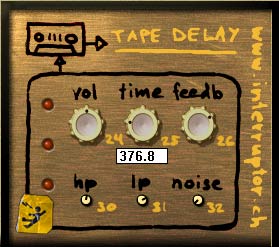
Thanks to Michael Bell-Smith for finding this, and for including my "Guitar Solo" video on his new co-curated delicio.us page of videos called Represent or Die. In RSS form the link feed becomes "the flagship D(elicio.us)TV channel."
Update: I should have explained the last quote better. As Michael mentions in the comments, he is "using del.icio.us as a blogging tool for DTV - a cool new RSS video downloader/reader (in beta). While currently mac only, and still buggy, it's well worth the download, if not for its amazing potential, then to check out Some Pig, a video art channel out of Providence featuring vids by Devin Flynn, Paper Rad (P-UNIT Mixtape) and others."
Paul Slocum announces the completion of the first release version of his Cynthcart, a program that turns the vintage Commodore 64 computer into a synthesizer (with a piano keyboard overlay covering your QWERTY keyboard). The cartridge, which also generates lo-fi psychedelic graphics, is available for purchase at the Atariage store.
The music made with the Cynthcart sounds great from the .mp3s; the SID chip's characteristic nasal sawtooth sound is unmistakable, and I like the third track, where Slocum has spliced it with scrambled vocal bits--also the fourth, which is a full blown song with rhythm programming. I know the chip a bit from working with Elektron's Sidstation synth, and yes, I'm a consumerist techphobic weenie for using a current piece of hardware instead of a killer mod of the original gear, but (this promises to be a constant theme today) I'm only abstractly interested in what's under the hood. I've learned a lot about softsynths this year and am increasingly drawn to big, user-friendly graphic interfaces where I can control sound visually.
Speaking of the SID and Sidstation, others doing good things with them are MEQ AND THE URS ("this page is no longer supported in Internet Explorer below version 7 and if you're still using IE you probably won't like this music anyway"--right, Jotsif, or because someone is surfing at work and doesn't have a choice, thanks for condescending to about half your potential listeners) and Receptors, which was one of my favorite acts at the last BENT (circuit bending) festival at the Tank in NY--still haven't posted my pic of him. Someone really ought to do some curating/compiling of the current SID music that's out there. With critical commentary! Dream on. The chatboards mostly talk about the gear, never composing music.
Jack Masters has a funny cartoon up on his page caricaturing the main Internet search engines. Yahoo! consists of signposts pointing in a dozen directions, Jeeves is servile but basically mentally defective, etc. The cartoon leads into a pro-Google, or rather anti-anti-Google rant by Masters that I've definitely been on the other side of. Yes, if Google starts to suck we'll stop using it and then we won't have to worry about it being all-powerful, and if separation of powers starts to slip we'll elect a more aggressive Congress that will stand up to the President. A few weeks back Masters posted a gnarly piece of electro-noise music that I really like. I sampled a couple of snippets from it for my song "Unfriendly Satellites," which I recently realized lacks a bass line and needs one rather badly--working on it. Regarding the Masters piece, can someone please explain the following exchange about it in his comments? I'm curious and baffled:
earthbound called, it wants its background music back
# posted by applesos : 6:29 PM
i thought earthbound's background music was like... a choir... i only have one song from it
# posted by Jack Masters : 5:07 PM
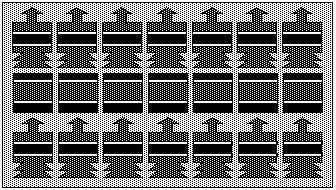
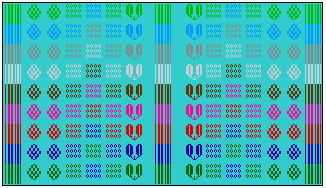
Via Travis Hallenbeck, African textiles using a programming language called Logo, specifically the GS LogoWriter on an Apple IIGS computer. The page linked to, a text written 12 years ago, goes into great technical detail as to how the patterns were created. I was not previously familiar with Logo or even that generation of Apples; it looks like another language-cum-family of gear (like Amiga, NES, etc) with a philosophy and a cult behind it. Obviously I'm spewing hot air here, being more interested in the beautiful finished product than how anyone arrived at it. But see What is Logo? if you're as un-up-to-speed as I am and want to know more.
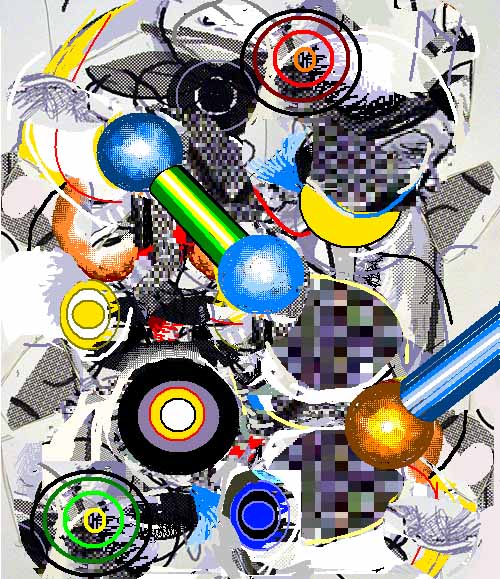
"Robollywood" [4 MB .mp3]
"Darken Room, Eat Pills" [mp3 removed]
Both pieces use samples from NI's "simple waveform kit," hence the videogamy bleeps, as well as MIDI files intended for drum kits, run through synths as lead instruments. Fans of super-fast nerdy contrapuntal prog-rockish keyboard playing might like "Robollywood"--I'm constantly surprised how well percussion scores translate into tonal playing, with adult supervision in the form of splicing and muting notes.

artist unknown
My essay on painter Kara Hammond appears here, along with some images of her work (link at upper right), a couple of which were previously shown on this blog. The occasion for the writing is her show at the Halsey Gallery, College of Charleston, South Carolina, the school where she is now teaching.
Below are three views of Werner Herzog's great film Grizzly Man. All are interesting, though Ross Douthat's piece is a tad over-the top in its religious references. The writers should give Herzog more credit for the film's intellectual and emotional heft, though; if it makes sense to talk about religion at all it's because of the layer of profundity his commentary and editing bring to the found material, even though, pardon the further and possibly contradictory qualifier, his interest in intense, ecstatic states seems purely secular. Lindsay Beyerstein nails how the narcissism of doomed ursine documentarian Timothy Treadwell tainted his own mission, but Herzog sees magic in Treadwell's camera artistry, actor-like temperament, and willingness to go "out there" to the furthest edges of experience. David Edelstein notes Herzog's contributions but thinks they're melodramatic, and of course they are, it's Herzog, but their success in steering how we view Treadwell's footage is none the less awe-inspiring. Also in response to Berenstain, I mean, Beyerstein, Treadwell's knowledge of the bears isn't really "shallow"--he's constantly dropping factoids in the film about how they mate, fight, hibernate, kill their young... Maybe this information is wrong, but he clearly learned enough to live with them at close quarters for thirteen summers before they finally did him in.
Ross Douthat:
Grizzly Man is a film about religious experience, among many other things, but not a form of religious experience that's familiar to most people in the still-Christ-haunted West. Human beings are caught between the animal world and the spiritual world, bound by fleshly requirements, but able to imagine themselves as immortal, freed from bodily concerns, quasi-divine - and in response to this problem, Christianity (and most other mainstream faiths) tells people that the way out is up, and that to escape the conflicts and miseries that come with being half angel and half ape, you need to become more like an angel, and less like an ape.Lindsay Beyerstein:
But the imitatio Dei isn't the only possible solution to the dilemma of being made a little lower than the angels. You could also go in the other direction, and give up on human reason, human self-awareness, in the hopes of returning to a pre-rational, pre-spiritual, entirely animal state. This kind of radical return to Nature - which is very different from, say, a Thoreauvian "going to the woods," in which the goal is contemplation, not participation - can be found in some pagan traditions, in aspects of Native American totemism and in some of the stranger cults of ancient Greece. The Secret History, Donna Tartt's great novel, is about the pursuit of just this kind of back-to-Nature religious experience. And so is Grizzly Man.
But Nature won't take us back.
More than anything Grizzly Man captures the paradox of narcissism. Treadwell can't relate to anyone or anything except as an extension of his own desires. He desperately wants to be liked and respected, but he can't step outside himself long enough to imagine how he's coming across to other people, or to animals, for that matter.David Edelstein:
Herzog and his informants search for meaning in Treadwell's life and death. What did he really accomplish? Very little, as it turns out. He didn't learn much about bears because he was overcome by his own gooey sentimentality. He didn't learn anything about himself. You keep wondering when he's going to realize how absurd he looks. Instead, he spent his months of solitude constructing elaborate cinematic "proof" of his own heroism. Ironically, the record shows the exact opposite.
Grizzly Man has the tang of the famous chapter in Moby Dick, Melville's sardonic answer to the Transcendentalist movement, which produced Thoreau (and Whitman). You might sit astride a mast and feel your oneness with nature, Melville wrote, but fall into the sea and you're going to get eaten. For all his attention to his bears, for all his boasts that he was "on the precipice of death" and could be attacked at any moment, Treadwell didn't fully see nature. Reinventing himself after years as a down-and-out alcoholic, he clearly turned the bears into his version of the "higher power" fervently embraced by members of Alcoholics Anonymous.
Was Treadwell suicidal? He often said that his life and cause might be looked at more seriously if he died in the wilderness, although the bear that ate him and his girlfriend was riddled with bullets by rangers before Treadwell had even been digested, and the chief lesson to draw from his story is to do the exact opposite of what he did--to keep one's distance from these huge predators. Parts of Grizzly Man are as bone-chilling as The Blair Witch Project—especially the footage from Treadwell's final days. After railing at humankind (was he bipolar?) and an altercation with an "obese" airport gate agent (what was that about?), he and his girlfriend returned to the maze at a time of year when most of the more tolerant bears were hibernating, and only the old and desperate-for-food ones remained.
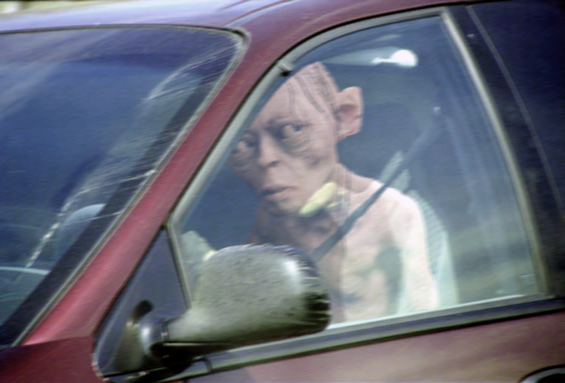
From E. Worthy, Early 21st Century Art (New York: Kramer Publishing 2035):
"Another Rubicon was crossed in the mid-'00s with the publication of the GNY05OG (Greater New York 2005 Online Gallery). This Borgesian project began at the instigation of "blogger" James Wagner (as citizen journalists were then known). In response to a Stalinesque ban on photography at the PS1 Contemporary Art Center in New York, Wagner called for artists to sketch the show and offered to post the drawings to the Internet. The response was astonishing--overcoming their natural territoriality, apathy about other artists' work and fear of not being seen as "playas," hundreds of artists flocked to the institution and submitted drawings to Wagner. The online exhibition was so personal, idiosyncratic and non-hierarchical that critics began describing it as "better than the original show" (Village Voice) and a "case of the map becoming the territory" (October). The art was viewed all over the world, revitalizing New York as a "dynamic center of art rather than just a series of year-round vegetable stalls" (The Guardian).And then I woke up. Wagner's actual gallery, now containing eight (!) drawings, is here. Please note the drawings have an anti-hotlinking feature that may require you to turn off your Norton to view them (I have to).
The show also marked the beginning of a new, meta-art, wherein artists used powers of observation, drawing ability, and Photoshop skills to create an enhanced online product somewhere between the physical and the virtual. The new work had a torqued up effect akin to the sampling phenomenon in music, where tweaked sounds became more punchy and "present" than live playing. Eventually, as we know, museums became physical "sample banks," with real-space objects serving much the same function as plaster casts of still life subjects in the 19th Century academy, that is, mere shells used as starting points for finished electronic work.
Bob Moog, inventor of the Moog synthesizer and revolutionizer of music, just died. May he rest in peace. Below are excerpts from two posts that appeared on this page last year about the film Moog. They were mostly critical, but the gripes were about the film and not the man, as I have nothing but admiration for him and his work.
The highest spots in Moog involve not the keyboard instrument but the Theremin, which Moog got his start building. Solos by Pamelia Kurstin and Moog himself are beautiful and otherworldly--music from thin air, only two controls (pitch and volume), no moving parts, it's the soul of economy and still inherently futuristic. How did we ever lose track of the concept?And later:
It's interesting to watch Moogs being assembled and to hear the inventor talk about them--he's quite the spiritualist, and says he intuitively knows what sounds the circuits will make. He emphasizes the importance of playing live before an audience, and seems to distrust "music made alone to be listened to by people alone." [...]
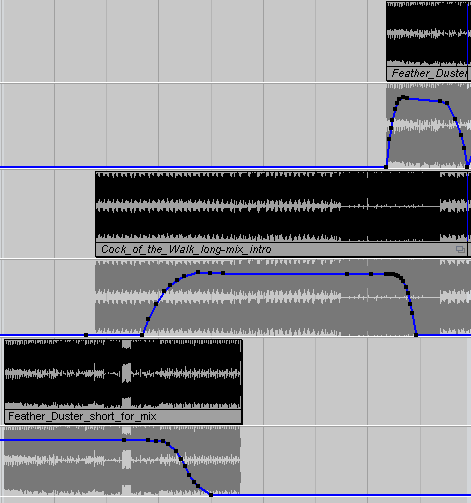
"Cock of the Walk (Siege Mix)" [6 MB .mp3].
"Blistering Lead" [mp3 removed].
"Be Three" [mp3 removed]. "Be Three" has been modified since I first posted it. Here's what I said about it originally:
This last one is arty in that it "goes nowhere," that is, it's a series of interacting "instrument blocks"--organ, fretless bass, rhythm box--that create a kind of false music I find strangely listenable. Some might say that about all my music, i.e., that it's static, machinoid, whatever, but I wouldn't agree with that--I generally don't find any interest if there isn't a hook in there somewhere. One thing I don't do is artificial dynamics like altering the tempo track or quantizing notes. The energy (to the extent it gets across) comes from the arrangement of notes and changes in volume and texture, not trying to imitate human playing. Machines are human-made and controlled, I've never bought the criticism that electronic music is "soulless," but do think that some aspects of digital production are more contrived and phony than others.The piece is still working with all those rudimentary elements but I added a few notes and started rearranging it into a song; intellectual interest only carries me so far. I may or may not keep fooling with it.
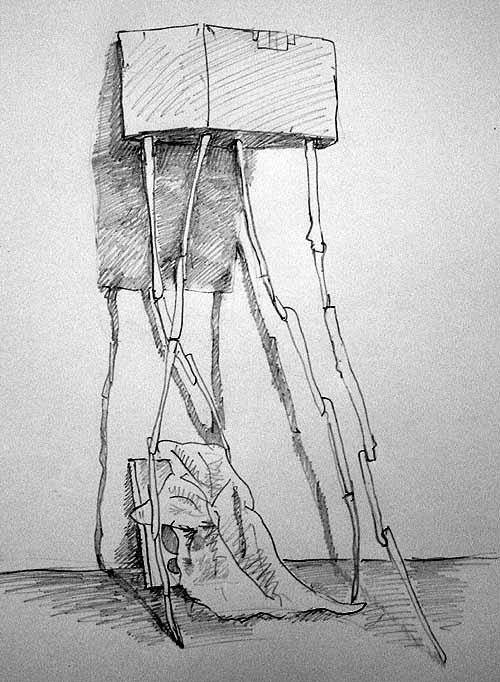
I have submitted this drawing to James Wagner for his online gallery of hand-drawn images of PS1's "Greater New York 2005." He initiated the gallery after finding out that the oh-so public-minded PS1 has a photo ban on all artworks. The image above is a detail of Gedi Sibony's Disguised as Material Properties. The materials are a cardboard box, twigs (held together with wood putty), plastic sheeting, and a wood panel with circular holes cut in it. The box is affixed to the wall and the "legs" appear to be half-supporting it, half dangling from it. Very crude, but nice. After War of the Worlds came out, it's hard not to think of a DIY version of the Cruise-menacing alien "tripods."
As for the show as a whole, one can see why it inspired a critical yawn. An awful lot of student-level painting: if this is what the Bush millionaires are clawing each others' eyes out over, we can only snicker at them. And we could all use a hit of whatever the curators were smoking ("Looked at a certain way, this is kind of good--pass me that pipe again.") Exceptions are Anna Conway's Magrittean painting of figures lying with their heads in tree-reflecting pools, next to another one of huge clown faces in storm-tossed seas, which are well-rendered and genuinely odd images. Dana Schutz is a good neo-neo-Expressionist, but her giant, multi-character Emil-Nolde-by-way-of-the-Dutch-Masters "anatomy lesson" canvas strains to be over the top.
As usual for this media-babysat generation, the videos fared better than the objects. Thumbs up for: Sue de Beer's new nonviolent work, which is becoming quite sumptuous in its use of colored gel lighting and classical photo-composition, albeit deliberately problematized by the splitscreen and without stinting on the essential agony of the pimply teen years; Meredith Danluck's slightly ghoulishly bleached out boy in tuxedo tails tapdancing to a trancy electro score; and Mika Rottenberg's sweat-wiping truckdriver with bicycle-driven conveyor belt feeding her new! more absorbent! tissues (also genuinely odd).
Middle east expert Professor Juan Cole helps penetrate the fog of Administration and media disinformation about what's going on in Iraq. The US has no chance against this insurgency without massive troop increases and a nationwide will to "win"--which means what exactly? Making the country safe for a government friendly to US interests? Who cares about that except the neocon crazies and Americans deluded by simplistic Clint Black songs? By invading without a plan to manage the aftermath, Bush really put his foot in the bucket, to use a Texas expression. Americans are paying for this stupidity with precious lives and untold sums of tax dollars.
Iraqi government spokesman Laith Kubba said of Wednesday's horrific bombings in central Baghdad, which left over 40 dead and twice as many injured, "Those who commit these crimes are the same ones who specialized in mass murder during the era of the tyrant Saddam." He added, "They have a plan that is composed of two stages. The first is to spread terror and grief serially, in order to break the will of the Iraqi people. The second is to attempt to overthrow the government through spreading chaos in the land."
Kubba is in part correct and in part in error, and he left out something big. Some of those behind the campaign of car bombings and other acts of terror are the old Baathist power elite (especially military intelligence, elements of the officer corps, and the secret police or mukhabarat). But some of them are Sunni jihadis who would not have been allowed to operate in Baghdad by Saddam. And others were relatively apolitical in the Saddam era but have been galvanized by a conviction that their country is suffering foreign occupation (Anglo-American at least, and perhaps Iranian as well). So it isn't correct to say that the perpetrators are exactly the same group as put all those Shiites and Kurds in mass graves, though there is certainly an overlap. Note how different Kubba's discourse is from that of the Bush administration, which almost never talks about anything but "al-Qaeda" in Iraq. Here we have a high-level Iraqi spokesman, and all he sees in the insurgency are Baathists.
The important thing he left out is that the plan actually has three parts. First the guerrillas force the Americans and British out. Then they destabilize Iraq. Then they make a coup and kill the elected government, along with Sistani and anyone else who gets in their way. Since the guerrillas have so many former military officers and veterans in their ranks, and since they know where thousands of tons of hidden munitions are buried, they believe they still have an edge over the ragtag Shiite militias such as Badr Corps and Mahdi Army.
From Atomic Cinema, which has some of my favorite writing on movies:
Is 40 GUNS the weirdest Hollywood western? The question boils down to whether this is crazier than JOHNNY GUITAR. I think it is... JOHNNY GUITAR is crazy because Nicholas Ray wanted it to be crazy. Sam Fuller’s special gift was that he didn’t seem to know he was crazy. 40 GUNS is just Fuller’s honest idea of the best way to do a western. And that’s pretty damn weird!
The craziness of 40 GUNS:
- The Song: 1950s westerns always had a ridiculous theme song. “Chuck-a-luck” from RANCHO NOTORIOUS is pretty comical but it’s no match for “Lady with a Whip,” the love theme from 40 GUNS.
- Skewed sexuality: In Fuller movies interaction between the sexes tends to be confusing and smutty. (e.g. UNDERWORLD USA and PICK-UP ON SOUTH STREET) In Fuller movies the sexes interact on a pheromone level, forming life-long sexual bonds on sight. (or on smell, I guess) FORTY GUNS is a censor-baiting cavalcade of raunchy single-entendre “humor” that flirts with art because the most leering lines are delivered dead-pan, as if the characters have no idea what they’re saying. “She’s quite a girl. I’d like to stay around long enough to clean her rifle.” You’re probably thinking, “girls don’t have rifles!” Well, they do in this movie, as well as whips. It’s so far gone that Fuller manages to make the vagina a phallic symbol. The cute girl in FORTY GUNS is a gunsmith. Her rifle is a running symbol focusing on the ridged interior of the barrel cleaned with repeated thrusts of a brush. (The rifled barrel POV shot that opens every James Bond movie seems to have been originated in FORTY GUNS.) Every time our leading man goes to the gun shop it’s an outlandish pantomime of gun barrel stroking and jerking.
- Male Bonding: This is a manly movie for manly men, particularly manly men who want to scrub each other’s backs. No movie cowboys ever took as many baths as these guys! After every fight, shooting or romantic encounter it’s back to an open-air frontier bath house for sing alongs and towel snappin’
- Barbara Stanwyck: Stanwyck is one of my favorite actresses but even in the 1930s she was never very attractive. In 40 GUNS she's easily the ugliest romantic leading lady in any Hollywood sound movie. I’m not talking about “plain” here. I’m talking about something so startling it would be weird not to mention it. She looks exactly like Medusa in CLASH OF THE TITANS. But whether intended or not, it works. When men in 40 GUNS are drawn to her it’s so implausible is unsettling, like she’s a sorceress. [...]
- The 40 guns: Wherever Stanwyck goes she is followed by forty gunmen on horseback. It feels very Hong Kong film. (Very much like Lucy Lui and the Crazy 88s in KILL BILL.) If Stanwyck wants a pack of gum in town this whole battalion rides into town behind her, then follows her back home. The 40 guns eat dinner at a very, very long table with her at the head. When our hero shows up at dinner-time to further his romance with her she tells the 40 guns she’d like a little privacy so they all get up and march into a little side-room that can barely hold them, like they were toy soldiers being put in their case.
- Generic Cast: Can you tell Barry Sullivan and Gene Barry apart? Yeah, me neither. I've seen this movie many times and I still can't tell which brother is dating who or who's been shot.
- Miscellaneous oddness: At one point a man is shot in the leg. The doctor runs over to examine the leg. “How is he, doc?” Doctor says, “He’ll live, but he’s blind.”
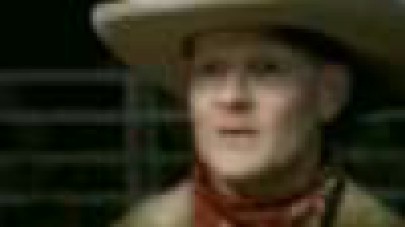
Web Roundup
Congrats to Michael Bell-Smith for the NY Times mention of his cubist remix of R. Kelly's "Trapped in the Closet" videos (that's how I'd describe it, anyway). By syncing and playing all five vids simultaneously, Bell-Smith spares us the agony of having to watch them end to end. I'm still marveling at a link Bell-Smith posted earlier to this "scary splash page for a paint-thinner company."
Sarah Hromack has a good summation of the havoc copyright extremists are wreaking on human expression, starting with a rundown of their recent successful campaign (so far) against Google Print:
Taking their cues from the music industry’s reaction to p2p file sharing, publishers fear that making texts available online will lead to unauthorized reproduction and distribution. I know that I, personally, am burning to print all 1,424 pages of War and Peace on my home printer, before collating, binding, and covering the whole mess in split cowhide. I’m seeing a multiple-volume desktop set here. Gold embossing, the works. Ebay, Haight Street—there is no limit to the pure profit potential of this scheme.Ed Rackley offers an especially clear analysis of what's happening in Darfur and its rich neighbor to the north, Khartoum, after he has spent the better part of this year in the Sudan working as a consultant in the international relief effort.
Musical prodigy Adrien75 has posted some new mp3s. One I especially like is the Neu!-ish "4th Song." [link to mp3 page updated: "4th Song" no longer available]

Art in America-recommended blogger James Wagner recently discovered that the Museum of Modern Art subsidiary PS1, a so-called alternate space in Queens, doesn't allow photo-taking of the "Greater New York 2005" exhibit! Man, considering the critical hatred-shading-to-indifference that show received, you'd think they'd want all the publicity they could get. A "no photo" policy benefits MOMA because its art is high-dollar intellectual property that pays dividends in the gift shop--can't have folks thinking this work belongs to everyone with the unfortunate consequence that Jay Bob sells Starry Night T-shirts in Springfield MO based on his digital camera pictures of same.
But an "alternate space" has a different mission, which is to introduce new, difficult, and/or undiscovered talent to the world. Or in this case, new, difficult, and/or undiscovered talent repped by major Chelsea galleries. One way you do this is by encouraging photographers and citizen-journalists to spread the word far and wide with as many visual aids as they can possibly publish.
Anyway, Wagner has a great idea, which is to post artists' sketches on his blog of works in the show. So far he's only gotten one, and it's not loading in my browser at the moment, but I think I'll mosey over to PS1 and do a drawing, as an act of protest of the image blackout and because the editorial thought-process of deciding what to draw appeals. My prediction is most artists won't want to do this, because so many are, let's be frank, geniuses, who have been told they must patiently wait their turn for institutional recognition: "playas" don't sketch other playas' work. * Fine, be a good vassal, I'm gonna go have me some fun.
*Also 'cause it's hard to use that internet thingie.
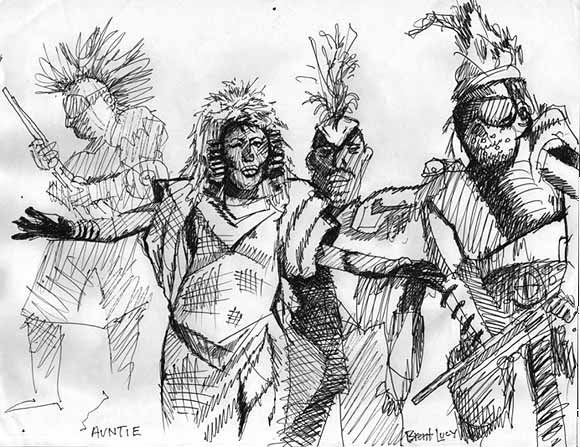
"Cock of the Walk" [mp3 removed].
"Feather Duster" [removed & replaced by "Cock of the Walk (Siege Mix)"--see below ].
Two tracks using the same 92 bpm hiphop groove (I think it's called Crack Dealer--great) to rather different effect. The titles are from Auntie Entity's quote from Mad Max Beyond Thunderdome: "But how the world turns. One day, cock of the walk. Next, a feather duster." (The excellent illustration, by Brent Lucy, comes from a Mad Max fan page.) The second tune has a "nice" melody of the calypso/rave variety. The first, grittier one uses mostly drum sounds from Clay Duncan's CD Kit 1 for Native Instruments. In the manual he imparts the rather fascinating tidbit that "These sounds I started making this year for the movie Thunderbirds and on [the TV miniseries] The Grid and Blade Trinity." So he's sharing in the entertainment industry gravy as opposed to a starving in a garret for the greater cause of techno, if anyone ever did that. Good for him and all, I know music is like acting where you list all your commercials and such in your book.
But someone has to ask: All those projects pretty much suck, though, don't they? The Grid--yeah, making us believe our government has a clue after four planes were successfully used as bombs in 2001. Thunderbirds--the movie that accused liberals of coddling Osama Bin Laden [update, whoops--that was Team America.] Blade Trinity, that's like the second sequel of a vampire superhero movie. I like the idea that music could spin off from these high-tech, high-dollar corporate makework projects, though, cargo-cult fashion: that little people can share the samples and make their own cute music that actually has the potential to be better than the source because it isn't made for some suit whose ultimate goal is to rip off the masses with overpromoted sensationalistic product. Sorry for the antiglobalist ranting but there has to be a better vision of the world than what these companies are selling. Yeah, I know I got my titles from a sequel to a sequel.
Addendum: I'm thinking now I'll combine these tracks, starting off with skronky bass stabs and bringing the "pretty" melody in at the halfway point--or making the bass stabs a long break. Oh, God, structure, I just want to be an obstinate serialist.
Addendum 2: Done (option 2): "Cock of the Walk (Siege Mix)" [6.3 MB .mp3]
Addendum 3 (November '05): Sorry this post is so mean-sounding; sometimes demons just take over. Also, not saying my music is "better than the source"--I just mean potentially someone's could be.
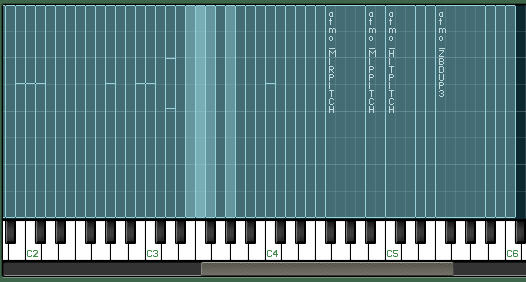
"Green March" [mp3 removed]. Dear J(ake) M(andell), thanks for the "green algae" drum samples you made for Native Instruments, and for throwing in a few tones that could be used for melodies. The samples are fuller and more ominous-sounding without all the volume-shaping that attaches to them in certain instruments (Battery), which is why I played them "straight" in Kontakt, but either way, brilliant work, you are inspiring people (me) to use the kit just to hear all the things it can do.
"Piano Bar" [mp3 removed]. Tickling the ivories with some slightly grunged-out Rhodes sounds. This one just sort of popped out (the best ones usually do)--most of the melody lines were placeholders for the real tunes and sounded good enough not to change.
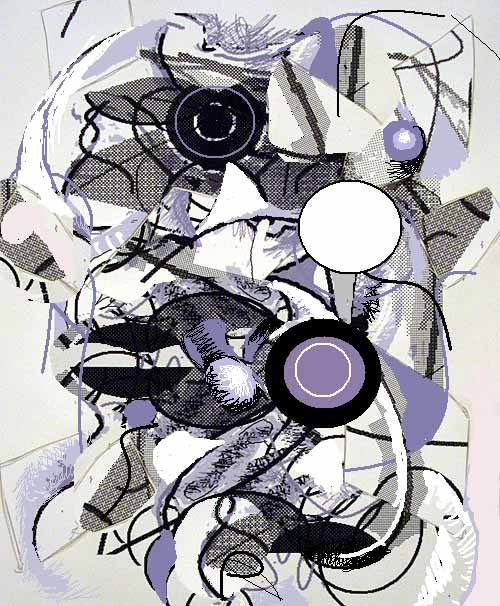
Werner Herzog's Grizzly Man, opening in movie theatres tomorrow, sounds creepy-fascinating. Herzog acquired the footage of a would-be documentarian of giant Alaskan grizzlies, and framed it with Herzogian narration and editing. From Village Voice writer Michael Atkinson's description, the bear guy sounds like a cross between Jane Goodall and the football-throwing damaged specimen in Napoleon Dynamite. Atkinson says the film awkwardly captures the essential contradictions between the naively nature-loving filmmaker, eventually killed by the bears he filmed, and Herzog, who as anyone who has heard his monologue about the jungle in Burden of Dreams knows, sees the natural world as an arena of grinding implacable forces. The footage included audio of the bear-lover and his girlfriend being killed, but the audience is mercifully spared it--other than to watch Herzog listening to it and then ordering an assistant to destroy it. I can already visualize that scene; not to take anything away from the tragedy, but Herzog is so serious he cracks me up, as he says, "against my better judgment."
More from my essay on Kara Hammond, completed and sent off this week to the gallery where she is showing: "The understated subject matter, willfully provisional style, and a whiff of mid 20th Century 'populuxe' kitsch all work in concert. When it comes down to it, putting a jetpack--a personal 'rocket belt' built but never mass produced in the ‘60s--in the same show with a Johnny-on-the-Spot, still the state of the art in portable evacuation, is just funny."
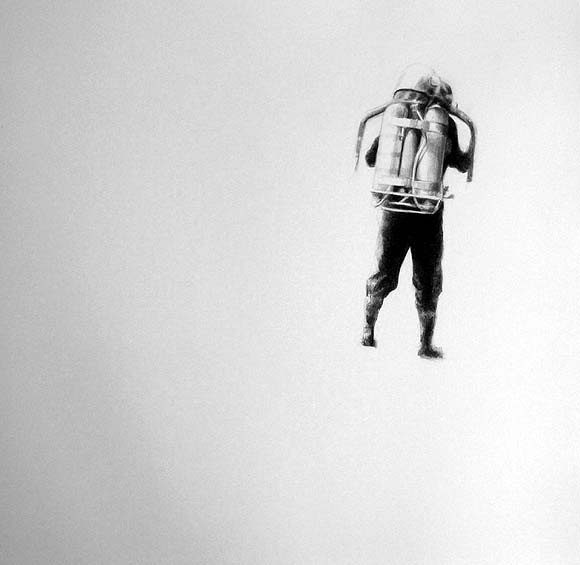

Museum to Show Artist's Fingernail Scrapings
Gordon Matta-Clark, the conceptualist and Late Land artist famous for revealing buildings' inner structures by chainsawsing big cuts in them, is good but overfetishized. Because he died at age 35 there's just not that much work--many weak scraps have been shown. The estate is still being picked over, first for real work and now for unfinished projects that can be "completed" and ultimately commodified. As Sarah Hromack and others have reported, the latest exercise in enshrining the bone chip of a saint is the "completion" of Fake Estates, a work deep in the research hopper while Matta-Clark still lived.
Matta-Clark was acquiring slivers of land around NYC "sliced from the city grid through anomalies in surveying, zoning, and public-works expansion." According to the press release
he collected the maps, deeds, and other bureaucratic documentation attached to the slivers; photographed, spoke, and wrote about them; and considered using them as sites for his unique brand of “anarchitectural” intervention into urban space. Matta-Clark died in 1978 at the age of 35 without realizing his plans for Fake Estates, and ownership of the properties reverted to the city. The archival material that he had assembled went into storage and was not rediscovered until the early 1990s, when it was assembled into exhibitable collages. [smarmy emphasis added]Showing an artist's raw material is bad enough, but the team of curators has assembled a team of artists to...here's that word...respond to Matta-Clark's escheated gutters and planting strips. If you thought after the Terminal 5 debacle we were done with this kind of vague, warmed over site-specificity, well, no way; this trend is forever. "Toland Grinnell will coat his curb in Staten Island entirely in expensive leather..." (Yes, that's made up.) The only thing we can hope is that when Chris Burden dies no one finds any unused bullets in his personal effects.
Having criticized Donald Kuspit's essay on digital art for metaphorical overreach and bad choices of work to champion, let's offer a few words of defense. Kuspit's supposedly dense artspeak can't be blamed for Damien Hirst's cut-up cows, a connection one commenter attempts to make. Kuspit believes in nothing if not the natural and the vital over cheeky sensationalism, which, again, Hirst practices only in part. Aligning Kuspit and Hirst is like saying "Greenberg, in his defense of Mary Kelly..." Compared to say, Derrida's writing, Kuspit's language cribbed from psychoanalyis isn't that dense. It's just wordy.
More vexing is current Eyebeam reBlogger Sarah Cook's tarring of Kuspit as a supporter of form over content. ("Seurat's pointilism makes him the first digital artist? An art critic caught up on form yet again. --sarah") Check out what Kuspit says about Seurat, though:
Seurat was the first artist to understand that vibrating sensations are structured in themselves as well as details in a visual structure. [That sounds tautological but we're coming in mid-argument.] To be a really modern artist, a scientific artist, meant to make these structures -- the hidden code of color, as it were -- visible. The more visible the coded matrix of sensations became, the more hallucinatory the representation seems, which is what happens in La Grande Jatte. Indeed, the more structured the vividness of the sensations seemed, the more the picture was totalized as an eternal pattern of vibrating sensations, the more ghost-like the objects represented seemed.If this is formalism, let's have more of it! Sounds like good drugs, to me. The problem with Kuspit's essay is he has found no modern equivalent artist worthy of waxing this eloquent about. That kind of rush, at least for now, can mainly be found in cinematic credit sequences, electronic music made in the likes of Reaktor, and some of the braincrunching Flash videos available for the downloading out there on the Internerd, to use a Gothamist term. Artists will catch up with these pioneering digital works eventually.
La Grande Jatte brings representation into greater question than [Manet's] Music in the Tuileries Gardens. Seurat’s pulverization of representation into a matrix, systematically organized, suggests that doubt and suspicion of representation are built into La Grande Jatte. Perspective continues to buttress the scene, like a backbone, but the perspective is beginning to buckle and flatten -- collapse -- under the enormous weight of the pulsing sensations. Seurat’s painting is a catastrophe in the making, a virtual apocalypse, indeed, the first picture that explicitly presents itself as a virtual reality, and that "argues" that reality is always virtual -- never really real, or, if one wants, it argues that the virtual is the really real. His figures are full-fledged phantoms, delicate, thin gossamers, no longer clumsy, thick patches.
Looking at La Grande Jatte, we are witnessing the death of the order of objects and the birth of the matrix of sensations as a unified field.
--reposted with minor edits, which means the URL changed, whoops.
Digital art duo MTAA link to a Donald Kuspit article that makes some over the top claims for digital work. I haven't studied the essay in depth but agree with about half the premise ("digital art is the new art; code is the new subject") and practically none of the examples. Now MTAA is duking it out in their comments with an anonymous meanie who makes the obvious argument that art has to have that undefinable something regardless of the medium and then backs it up with ad hominem attacks on MTAA's twhid. Guys, don't give that fellow too much of your brain power. (Like I follow that advice with rude anonymous commenters.) More on the Kuspit soon--it's surprising he wrote this because he's usually the spokesman for the Healing Power of Art and fecund interiority over bloodless conceptualism. Possibly he's in full contrarian mode but then his principles are never rock-solid.
Update: The Kuspit piece is disappointing. He bases his link between early Modernist painting and the computer on squishy metaphors of pixeled space that leap across several decades and don't take into account photographic grain, TV rasterizing and other developments that came between Seurat and the first computer art in the 60s. "Code" is also used in a broad metaphorical sense so it could mean almost any systematic approach to art. The only current digital work he discusses in depth is Michael Somoroff's video Query (2004), which is more of that damn art about art, riffing on Duchamp's and Richter's famous nudes descending staircases by subjecting them to the inevitable high-tech imaging analysis. Ugh.
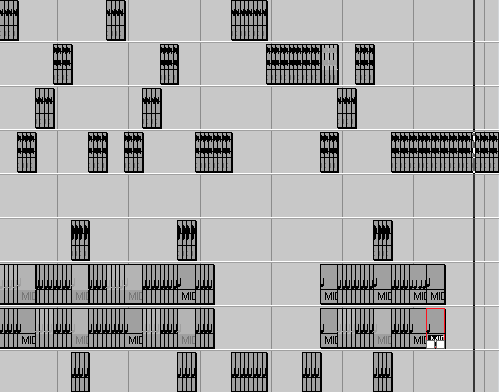
"Unfriendly Satellites" [mp3 removed]. This is partially a remix of another blogger's .mp3--only a couple of snippets of gnarly analog (?) noise yanked out of a much longer but very interesting tune. That's all I'm saying for the moment. The pretty-sounding refrain is a snatch from a Kontakt FX sample called "3 Friendly Satellites," a great title for an evocative bit of sound. The samples were timestretched to fit the sequencer grid and treated with a few Cubase insert effects. The drum-and-bassy rhythms are done in Intakt, a beat-slicing instrument. As long as we're revealing trade secrets (ha), here's the rundown on the previously-posted "1987" [4.7 MB .mp3]: the Vermona drum hits were downloaded off the internets, trimmed in a .wav editor, and further tweaked in Battery. The main chorded theme is done with Reaktor's Titan synth (my favorite so far), and the rising, slightly scary bass chords are done with another softsynth called the Linplug Alpha, a real gem of an instrument. OK, that's it for advertising consumer products. It's all software and I'm still the music-creator, right?
Update: snipped a few bars of "Unfriendly" near the end. There's redundant and then there's redundant. Update 2: took almost 30 seconds out near the end. Same reason. Update 3: added 5 seconds back in for a thrilling (or at least logical) climax and took a screen shot.
The New York Times editorial page struck again today with a stupid navel gazer about blogging. The Daily Howler nails it, as usual:
DEEP THOUGHTS BY JACK HANDY: Someone decided it was time to wax eloquent. So the Times began to ponder the Net. In the process, someone even wrote this:The Times harped on the sheer staggering number of blogs, as if to say, they're like mayflies, and could never be as important as centralized, edited media. Reality check: some blogs are better than others, some are better than the mainstream press, most disappear after a few weeks--which ones do you think Times worries about enough to try to trivialize?NEW YORK TIMES EDITORIAL (8/5/05): It's natural enough to think of the growth of the blogosphere as a merely technical phenomenon. But it's also a profoundly human phenomenon, a way of expanding and, in some sense, reifying the ephemeral daily conversation that humans engage in.“Hmm,” we quickly found ourselves wondering. Have we been engaged in “a profoundly human phenomenon, a way of expanding and, in some sense, reifying the ephemeral daily conversation that humans engage in?”
We gave it some thought, and then we replied: “In a sense—but not as such!”
The growth of the blogosphere is “a profoundly human phenomenon, a way of expanding and, in some sense, reifying the ephemeral daily conversation that humans engage in?” In fact, blogs became necessary when the perfumed royals of mainstream media began to write, think, cogitate and generally waste time like that.
A PREDICTION: This sentence will gain the most ridicule: “Perhaps the strongest indicator of the importance of blogdom [is] the extent to which media outlets are creating blogs—or bloglike manifestations—of their own.” As we’ve long said—if these lords of self-importance didn’t exist, no one could ever dream them up.

Some pieces of mine hanging in the curator's office at Lothringer Dreizehn, an art space located at Lothringer Strasse 13 in Munich. The curator, Courtenay Smith, originally showed the work in her gallery homeroom. Hand drawn using the old computer program MSPaintbrush, the images of what I would call everyday media women were shown a couple of times in New York in the late '90s. I emailed a set of .BMP files to Smith in 2000 and she printed them on a medical plotter and "stretched" (i.e., folded) the paper on canvas stretchers. Her set actually looks better than the ones I printed here in the States.
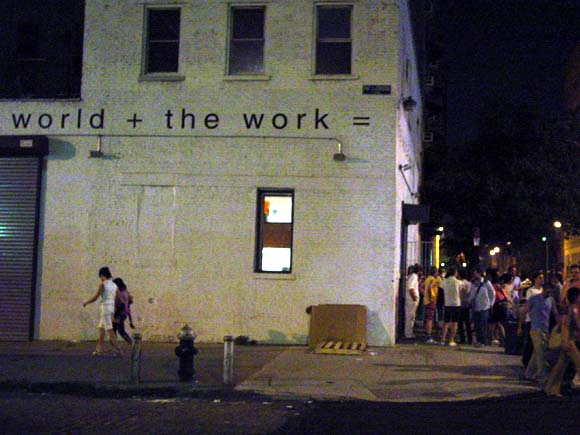
NY Cops Crash Gavin Brown Afterparty
Mellow Crowd Shouted At, Sent Home by New York's Finest at "Drunk vs. Stoned 2" Exhibition Post-Opening Barbecue
Things have been bad, civil-liberties-wise, after 9/11 and the Republican Convention mass arrests, but the cops seriously need to find more productive uses of their time. Tonight several plainclothes entered a private party on the rooftop deck above Gavin Brown's Leroy Street gallery, ostensibly alarmed by seeing a few bottles on the sidewalk. They caught Brown holding a baggie, grabbed him by the arm and led him out of the party, then got angry when a smart aleck guest allegedly threw a hot dog at them. Before arresting Brown on a minor possession charge, they forced him to stand up in front of his guests like an errant schoolboy and ask "who threw the hot dog." I shit you not. When no guilty hot dog thrower came forward, they kicked everyone out of the party. One cop violently slammed shut the barbecue grill and another of the little bullies (for some reason they were all short) stood on a bench and announced "Whoever is the last to leave comes out in handcuffs." Everyone there, which included some art world personages, filed out in a state of shock. Amazing to think that New York was once called "Fun City."
Update: Here's the NY Post Page Six version, which of course takes the cops' side; I edited my post based on some of this info:
DRUNK, STONED AND CUFFED FUN-loving art gallerist Gavin Brown managed to get buzzed while building a buzz for his new show, "Drunk vs. Stoned 2." The British bad boy was arrested Thursday night for possession of a small bag of pot at the raucous opening of the exhibition at his Greenwich Street gallery, which was transformed into a "Deadwood"-style saloon complete with swinging doors and a jug band performance. All that old-time revelry resulted in empty beer bottles littering the street in front of the space, which spurred cops to investigate. After they crashed the party and spotted Brown holding a bag of pot, officers brought him outside. "They were being very cool until someone threw a hot dog out the window at them," Brown told us. "It basically broke the good will. That's when they put me in handcuffs." Empty beer bottles, marijuana and flying hot dogs would seem perfectly natural at a show featuring work by legendary counterculture cartoonist R. Crumb. According to a press release hyping the show, the "two most familiar forms of intoxicated transcendence are examined through a clouded lens, blurred by pot smoke and beer goggles."Oh, yeah, someone threw a hot dog, poor babies, and "held a bag of pot," I guess that's a good reason to threaten a hundred or so well behaved partygoers with arrest. As for the beer bottles--what New York street doesn't have bottles lying around? Check out the photo--see all the bottles? I don't either. The mess was nothing noticeable, and this was not a wild party, sorry to be boring and put a damper on a bad boy's legend-building.
I got to see some of Paul McCarthy's early work--which I've always been mildly curious about--at the Haus Der Kunst in Munich this week. Unlike US art institutions, which filter art for the delicate sensibilities of small children, Victorian grandmothers, and Newt Gingrich, European museums don't protect viewers from the sight of icky penises and soiled butt cheeks. Like Charles Ray, who we mostly think of now as a conceptual sculptor, McCarthy comes from the late 60s/early 70s performance art-meets-black and white documentary photo tradition, which famously produced Chris Burden, Vito Acconci, et al. The earliest McCarthy works on view were Earth art-style pieces such as "Rolling a Bowling Ball Down a Mountain" and "Flying From Salt Lake City to LA," documented with rigorous photo grids. Later, McCarthy entered the body art canon with the performances "Painting Lines on the Wall Using My Face and One Shoulder" and "Plastering My Head and One Arm into the Wall." (All titles are approximate.)
By the mid 70s, he had snapped and begun producing his signature work, which could be succinctly described as "Writhing Around Half Naked in Meat and Assorted Condiments." The actual title of his breakthrough video is Sailor's Meat/Sailor's Delight, 1974, which Paper Magazine describes thusly:
...McCarthy donned a pair of woman's see-through panties, blue eye shadow and a blonde wig and proceeded to straddle a queen-sized bed smothered in raw hamburger meat and catsup. From there he went on to rub raw flesh across his chest and penis, mimic sexual intercourse with a jar of mayonnaise and a makeshift phallus, and urinate on a piece of sausage before shoving it down his throat. If that weren't enough, he ended the piece by smashing a bottle on the floor and walking barefoot on the shards of glass.I watched most of this vid at the Haus Der Kunst, sitting on a seat in the main gallery with all this kinky sexual imagery right out there in plain view. There were no furtive darkened rooms for creepy behavior as in the US, but headphones did protect the other museumgoers from McCarthy's disturbing grunts and Deliverance-like squeals. Damn, the early 70s were an interestingly depraved time, partly owing to the end of the sexual revolution that conservatives are always complaining about, partly because the median age of the US population was about 22 and cranky oldsters were not allowed to run the show, as they do now. John Waters had the jump on McCarthy by several years for the filming of antisocial, antipodean behavior--check out the "rosary job" in Multiple Maniacs (1970) to see how far courageous filmmakers won't go now. The main difference was Waters hadn't entered the art world yet--McCarthy's work came out of a fairly disciplined, non-theatrical tradition of testing visual boundaries. Lack of pacing and production values were built into this type of video. Not sure what my point is here, except to say that to the extent LA wants to claim McCarthy as some kind of art world response to the film industry, there were far more maverick filmmakers anticipating what he did.
The Haus Der Kunst featured recent video and sculpture by McCarthy, much of it centered around a lunatic inversion of Disney's "Pirates of the Caribbean" theme park ride. The screaming, pissing, and rolling in Hershey's syrup is a group romp these days, with larger budgets and casts. I like the artist's later work OK, probably more so in a public context, in Europe, than at Luhring Augustine, where the faux-tony exclusiveness of the Chelsea gallery environment tends to suck all life out of art. Stlll, it's fascinating to see how artists got where they got--to experience the original jarring moments that made their reputations, as opposed to the professional, institutionally-supported continuation of those moments.

Below are some raw notes towards the essay I'm writing on Kara Hammond's work. These will change as as the writing is fleshed out. The image above is Tyvek Beach House, oil on canvas, 2005.
Kara Hammond describes the imagery in her paintings and drawings as "scenes of everyday human existence." That’s as good a summary as you’re likely to find of this straightforward but strangely varied collection of suburban homes, airport buildings, storage sheds, space vehicles, office complexes, freeway ramps, trash receptacles, outdoor toilets, and other artifacts of the consumer-inflected landscape.
The work is "post-" quite a few things, to use a bit of art historical jargon. They are post-commodity art in the sense that they are not preaching about humankind’s intrusions into the natural environment but merely recording them as factually as possible. They are post-appropriation in that the recording more or less takes for granted art’s manipulation of signs, and the curious relationships that arise when painterly subjectivity meets the photographic record.
But the term post- usually implies a residue of what came before, and one still sees a skeptical, theoretical bent at work in these placid, some might say traditional-looking subjects. Images as reductive and open-ended as haikus on the individual level reveal their critical drift when seen cumulatively.

Just got back from an inland surfing tour and...not really, I've been vacationing in Munich, Germany, and will have a few more pics up soon. The one above depicts the usual gang of nuts who surf the big standing wave of river water that perpetually flows near the entrance to the English Garden.
